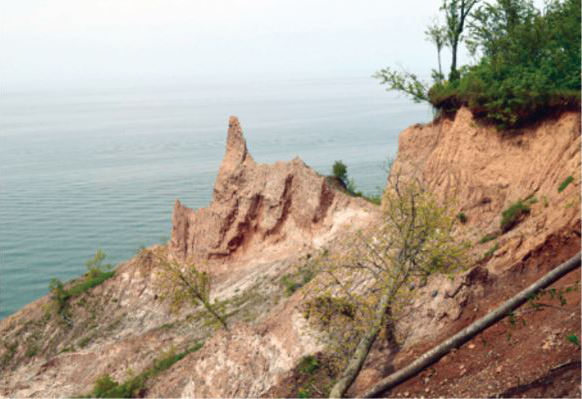Contact:
Heather Weitzner, Great Lakes Coastal Processes and Hazards Specialist, New York Sea Grant, E: hw528@cornell.edu, P: 315.331.8415
Newark, NY, February 4, 2016 - New York has a diverse shoreline along
the Great Lakes that includes coastal landforms such as sand beaches,
dunes, offshore bars, bluffs, cobble beaches, wetlands and various
combinations of these features. Some of these landforms provide erosion
protection, reducing the vulnerability of landward areas and the
naturally formed and human built environment found there. These areas
are also susceptible to erosion and accretion (build up of sediment)
caused by such forces as wind and waves, which help shape the shoreline.
Coastal landforms found along New York’s Great Lakes shorelines are the focus of this New York Sea Grant six-page fact sheet (pdf), which features colorful diagrams of how different ecosystems—including wetlands, bluffs and dunes, beaches and
off-shore bars—can be impacted by erosion
and accretion. While humans can impact the shoreline by intensifying
erosion and accretion, this fact sheet addresses how coastal landforms
are affected by the more natural forces and factors that influence
shoreline evolution.
The diverse landforms found along New York’s Great Lakes shorelines can
vary significantly depending on location. Although some of these coastal
landforms serve as natural erosion protection features, they are also
susceptible to erosion and accretion caused by such forces as wind and
waves. These forces help shape the shoreline, which is a dynamic
environment that evolves under the effects of both natural and human
influences.
For additional publications and to learn more about natural processes
and possible management alternatives when faced with their effects, see
New York Sea Grant’s Great Lakes Coastal Processes Web site, www.nyseagrant.org/glcoastal.

Bluffs found along New York’s Great Lakes shorelines are affected by erosion resulting from a variety of factors including waves, high water levels, groundwater seepage, and runoff. Photo: Heather Weitzner / NYSG.
More Info: New York Sea Grant
New York Sea Grant (NYSG), a cooperative program of Cornell University
and the State University of New York, is one of 33 university-based
programs under the National Sea Grant College Program (NSGCP) of the
National Oceanic and Atmospheric Administration (NOAA). The NSGCP
engages this network of the nation’s top universities in conducting
scientific research, education, training and extension projects designed
to foster science-based decisions about the use and conservation of our
aquatic resources. Through its statewide network of integrated
services, NYSG has been promoting coastal vitality, environmental
sustainability, and citizen awareness about the State’s marine and Great
Lakes resources since 1971.
New York Sea Grant maintains Great Lakes offices at SUNY Buffalo, the
Wayne County Cooperative Extension office in Newark and at SUNY Oswego.
In the State's marine waters, NYSG has offices at Stony Brook University
and Stony Brook Manhattan, in the Hudson Valley through Cooperative
Extension in Kingston and at Brooklyn College.
For updates on Sea Grant activities: www.nyseagrant.org has RSS, Facebook, Twitter, and YouTube links. NYSG also offers a free e-list sign up via www.nyseagrant.org/coastlines for its flagship publication, NY Coastlines/Currents, which is published several times a year.